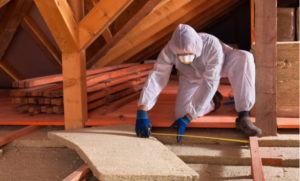Pest control is the management of unwanted organisms that damage or interfere with desired plants, animals, or people. Control methods include prevention, suppression, and eradication.
Prevention includes eliminating attracting materials, such as stacks of newspapers or cardboard, and sealing cracks. It also involves identifying the pests and their habits to tailor treatment, like caulking around a window, or placing bait in an area they frequent. Contact Killian Pest Control now!

Ideally, pests are dealt with through prevention rather than suppression or eradication. This is the best way to keep costs down and to avoid health concerns and property damage. It is also the most environmentally conscious and responsible approach.
The goal of preventive pest control is to remove food, shelter, and water sources that attract and sustain pest populations. Often this can be done through regular maintenance, such as sealing cracks and gaps in walls, doors, and windows; resealing trash cans; removing clutter from the home; and maintaining landscaping to eliminate accessible pathways into the building.
Clutter provides hiding places for pests, and food in open or loosely sealed containers makes them easy to find. Regular cleaning will also help to keep pests away from homes and businesses. This includes wiping down counters, floors, and appliances; vacuuming carpets; sanitizing drains; washing bed linens; and emptying garbage cans.
Maintaining sanitary conditions also helps to deter pests, especially rodents. In hospitals and care facilities, keeping a clean environment is essential for patient safety and preventing infection. Pest control is important to ensure that mice and rats don’t chew on wires, or gnaw through catheters and other devices, and that they are not carrying bacteria and viruses that can cause disease in immunocompromised patients.
Preventative pest control services may include traps, baits, and physical barriers. These are sometimes combined with other methods of prevention such as adjusting the climate, by using ventilation and humidity controls.
In addition, adjusting the weather can affect pests directly by reducing their numbers or inhibiting reproduction. Rain, freezing temperatures, drought, and other weather changes can kill or suppress pests. It can also indirectly reduce pest populations by affecting the growth of their host plants or destroying their habitats.
Preventative pest control can be supplemented with biological controls, such as predatory insects or pathogens. These are usually released in large numbers and can be very effective in controlling pests. This type of control is also very safe for the environment and human beings, as long as it is used correctly. This requires regular monitoring and adherence to local, state, and federal laws.
Suppression
Some pests, such as cockroaches and mice, can be difficult to eradicate once they have become established. In these situations, the goal is usually prevention rather than eradication. However, if the cockroaches or mice are damaging the environment, eradication may be necessary. This is often the case in commercial or hospitality businesses where food is prepared and served, but it can also apply to homes. Legislation and strict hygiene guidance mean that infestations are less common than they once were, but they can still happen.
A good way to prevent pests is to make sure that everything is stored properly, and that food waste is disposed of regularly. This will prevent the food from attracting pests. Other preventative measures include blocking any holes that are easy for rodents to crawl through, and fitting pest screens over windows and doors. These steps are especially important in retail and hospitality environments, where food is kept on display or stored openly.
Another method of preventing pests is to monitor them regularly. This can be done by scouting or trapping. It can also be done by examining the damage caused by a pest, or checking for their presence in the environment. Monitoring can also include evaluating the environment or conditions that are conducive to the survival of a pest, such as water, temperature, and light levels.
Threshold levels are sometimes set for pests, and control action is taken when the threshold is exceeded. These levels are usually based on environmental, health, or economic considerations. For example, it is unacceptable for rodents to gnaw through electrical wires, so a threshold level has been established below which pest control action will be taken.
Cultural practices are also used to reduce the numbers of pests attacking cultivated plants. These practices can involve altering the host plant, changing the condition of the soil, and adjusting the timing of planting and harvesting. They can also include mowing, mulching, and pruning, and they are especially effective in reducing fruit fly, gypsy moth, and Mediterranean fruit fly infestations.
Other biological methods of controlling pests include using parasitic nematodes. These are microscopic worms that live in the soil and feed on pests such as fleas, grubs, and ants. The nematodes are available in a variety of species, some of which are helpful to plants and others that are harmful.
Eradication
Pest control is a form of pest management that involves eliminating or controlling unwanted creatures. These creatures can include insects, rodents, and weeds. They can cause property damage as well as pose health hazards. For this reason, it is important to keep them away from homes and businesses. The most common way to do this is through pest control methods such as traps and extermination. These methods can be very effective especially if used properly. However, there are other options as well. One such option is to hire a professional. These professionals are known as pest control technicians and are trained to use different methods to eliminate or prevent pests from invading homes and businesses.
Eradication is a difficult goal in outdoor pest situations where prevention and suppression are the main goals. It is more common in indoor situations where there is a zero tolerance for certain pests, such as bacteria in operating rooms and other sterile areas of health care facilities. Eradication programs for Mediterranean fruit fly, gypsy moth, and fire ant are examples of these types of initiatives.
Physical traps and netting are other examples of pest control methods that are not as harmful to humans and the environment as chemical solutions. However, these methods require more time and effort to set up than pesticides. Additionally, they may only be effective in a limited area. Moreover, they may not be as effective against resistant species of pests.
Chemical pesticides offer a quicker, more convenient way to kill or control pests. They are often available in the form of sprays that can be applied directly to suspected pest areas. When using these products, it is important to follow the manufacturer’s instructions closely. This will ensure that the product is used correctly and minimize any risks associated with it.
Another type of chemical pest control involves the use of parasitoids to kill or control pests. Parasitic nematodes, for example, are microscopic worms that live in the soil and consume or parasitize a variety of different pests, including fleas, grubs, and cockroaches. This is a good alternative to pesticides because they are more environmentally friendly and do not pose any significant health risks.
Biological Control
Biological control is an effective method of suppressing pests and can reduce the need for other management practices. It uses living organisms (parasites, predators, disease agents, and competitors) that are adapted to the specific pest species. This can be done through conservation and augmentation of natural enemies occurring in production fields or greenhouses or by importing and releasing new biological control agents to establish permanent populations. Biological control is usually part of an Integrated Pest Management (IPM) program. It is often referred to as “natural” or “organic” control because it is less dependent on synthetic chemicals.
The goal of classical biological control is to bring the pest population below economic thresholds, not eradicate it. The success of the technique depends on the quality and number of natural enemies introduced, their adaptability to the environment, and other factors such as timing, release site, and agronomic management. It may take six to ten generations to determine the effectiveness of biological control.
Conservation of native or existing natural enemies is the most widely used method of implementing biological control. This can be accomplished by allowing natural enemies to remain in the field or greenhouse, providing the necessary habitat for them, or through augmented releases of predacious insects or parasitoids to supplement populations of their target pests. This type of control is most common in organic farming systems.
Biological control requires more planning and record keeping, takes longer to achieve results, and can be more expensive than other forms of pest control. To be successful, a broad knowledge of the pest and its natural enemies is needed. Biological control also tends to have more side-effects on biodiversity than other forms of pest control, but careful application and understanding of the biology of natural enemies can mitigate these effects.
PPQ is committed to safe and responsible biological control and integrates monitoring and evaluation as integral parts of all biological control implementation projects. This approach ensures that the risk of negative impacts to human health, natural areas, and the environment is minimized. The agency will continue to work closely with producers, state departments of agriculture, and weed and insect specialists on the development of sound biocontrol programs.





